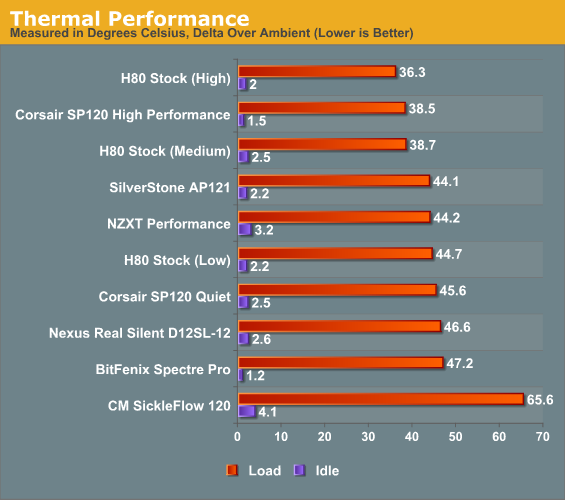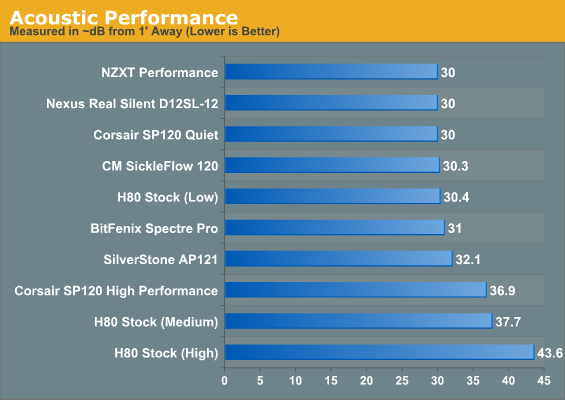Choosing the Best 120mm Radiator Fan: Testing Eight Fans with Corsair's H80
by Dustin Sklavos on August 23, 2012 12:01 AM ESTTest Results
Before we get into the performance results, a refresher: all eight fans on one chart for comparison. Note that if we're not taking noise into account, the highest static pressure fan should theoretically be the best performer. Our H80's fan settings are also only active with the stock fan; all others run at the full twelve volts.
| Fan | Airflow (in CFM) | Static Pressure (in mm/H2O) | RPM | Rated dBA |
| H80 Stock | 46-92 | 1.6-7.7 | 1300-2500 | 22-39 |
| SP120 Quiet |
37.85 |
1.29 | 1450 | 23 |
| SP120 High Performance | 62.74 | 3.1 | 2350 | 35 |
| SilverStone AP121 | 35.36 | 1.71 | 1500 | 22.4 |
| BitFenix Spectre Pro | 56.22 | 1.24 | 1200 | 18.9 |
| Nexus Real Silent D12SL-12 | 36.87 | 1.2 | 1000 | 18 |
| CoolerMaster SickleFlow 120 | 69.69 | 2.94 | 2000 | 19 |
| NZXT Performance | 47.27 | 0.95 | 1300 | 25.35 |
As far as static pressure goes, most of these fans are hanging out in about the same neighborhood. Acoustically, only Corsair's SP120 High Performance and stock H80 fan are even rated to go above the noise floor of our sound meter, though it's clear the stock fan is designed to move heat as fast as humanly possible. Let's see how all of these theoreticals worked out in practice, though.
Ambient temperatures ranged between 24C and 26C, and the margin for error in results is roughly 1C.

Thermally, if we ignore the H80's stock fan, the SickleFlow should've eaten the competition alive, but as it turns out CoolerMaster's specifications were more than just a little optimistic, as it was hands down the worst radiator fan we tested by a wide margin. If we organize the fans by rated static air pressure, they'd rank from best to worst: SP120 High Performance, SickleFlow 120, SilverStone AP121, SP120 Quiet, BitFenix Spectre Pro, Nexus Real Silent, and dead last, the NZXT Performance. As it turns out, though, only the SP120 High Performance really performs in line with its specifications; the rest just bunch up while the SickleFlow 120 is clearly the worst.
So how about acoustic performance?

Well, at least CoolerMaster's fan is quiet while it cooks your processor. To get that great thermal performance from the SP120 and H80 stock fan, though, you're going to have to put up with some noise. Note that these are load noise readings; the H80 stock fan idles at or below our sound meter's 30dB threshold at Low and Medium settings while sitting at 34.3 dB at High.
Interestingly enough, despite having among the worst rated specs, NZXT's Performance fan seems to find the best balance between thermal performance and acoustics; Corsair's SP120 Quiet does little to justify itself over the stock H80 fan. Corsair's engineers also turned out to be mostly right on the money: the H80 stock fan by and large seems to be the best choice, at least for the H80 itself. Its Low setting is competitive with the other fans both thermally and acoustically, while its Medium setting is competitive with the SP120 High Performance fan. The High setting is essentially unnecessary.










113 Comments
View All Comments
Hummingbird - Thursday, August 23, 2012 - link
I don´t think that this fan roundup really helps to decide which fan is the best out there as long as the Corsair H80´s radiator is far away in terms of it´s dimensions (depth and fin gaps/distance) from the standard radiators which are normally used for H2O setups.eric appla - Thursday, August 23, 2012 - link
Thank you for efforts with the review Dustin. When I seen Anandtech doing fan review I was very excited that I'll see very detailed and scientific approach as I'm used to from AT articles. Unfortunately this review was not fully what I expectedWhat I'd find useful in the Fan reviewes is also some CFM mesurements and noise measurements.
Noise measurements are very tricky as even A weighted dBA noise level is not telling full story. I would suggest to provide noise spectral picture as it can show at what frequencies are the dominant components of the noise. Some fans do hum, some squeek.
On the CFM and static pressure front it will be interesting to measure them in few scenarios.
1) open air (case fan scenario)
2) dust filter (case fan scenario)
3) low restriction radiator for example XSPC RX series
4) medium restriction radiator for example XSPC RS series
5) high restriction radiator for example XSPC EX series
Pretty much every radiator manufacturer makes few different radiators optimized for different fans based on the static pressure and airflow they can deliver.
Full review like this will show people that there is no single best fan in the world, there are just best fans for particular usage scenarios.
Challange is on :)
For Fan reviews to use with radiators I usually go to websites specialized on this narrow subject such as martinsliquidlab or skineelab as they have the required test equipment. Have a look at what these guys do, I think you'll find it exciting and inspirational and as I know you based on your approach to reviewes you'll surely find a ways to improve their methodologies even further.
Thanks again for all the efforts
krumme - Thursday, August 23, 2012 - link
A spectral plot wont bring us any closer, as there is dynamics involved to, and the charateristics of that dynamics. Besides that its expensive to do.Just add a colum with subjective impression/valuation and notes, fx. clicking, high picth tone..., even distributed...
Its the subjective that matters in the end.
Robalov - Thursday, August 23, 2012 - link
Nice article and get's right to the point, however I'd like to see 20+ fans tested.They're are so many touting that their 'special' design knocks the socks off the others.
Fans don't seem to get the air time (ba dum tiss) of other components are are left entirely up to personal recommendations on the forums, as the specs are just massaged or even outright lies.
As an aside, CoolerMaster really are a horrible brand.
BlueReason - Thursday, August 23, 2012 - link
First off, it's nice to see Anandtech making an effort to evaluate fans, a component sorely under-prioritized in rig setups (not to mention extremely difficult to review).However, as stated by others, the NF-F12 really should have been tested. I don't even like any of Noctua's other fans, but the F12 is possibly the most specialized, single-purpose consumer grade fan on the market, engineered ground-up for heatsink performance. Whether it delivers on that performance is debatable (in my experience, it does), but its exclusion from the comparison is rather odd.
Are any of the reviewed fans even PWM?
On a side note: some F12 units seem to have acoustic issues, hence the occasional "loud" comments. My first F12 suffered from this and was replaced by Noctua, to good effect.
khanov - Thursday, August 23, 2012 - link
No no no. You can't say that those Corsair fans win, since they only manage to equal the performance of Noctua's "old gentleman" NF-P12. That is not a win from Corsair as those Noctua's have been available for 6+ years now (but still it is a good first effort from Corsair).None of the fans you tested can actually best the performance of a Noiseblocker M-12P at the same or lower sound pressure level on a low profile, high-fin-count rad. (and that is what these high pressure fans are for, right?). So the real winner is Noiseblocker, but you decided to exclude them along with Noctua. Shenanigans, Dustin.
Noctua's NF-P12 are a good second best for many peeps into water cooling and are usually available at a reasonable price. If you are planning to push/pull a 3x120 or 4x120 rad for example, then the cost of 6x or 8x your chosen fan adds up very quickly. So to be reasonable about it the Noctua's should realistically win simply because the Corsairs are WAY overpriced right now (flavour of the month?).
Noiseblocker's M-12P's are still the real performance winner (cooling vs perceptible noise) but may cost you several arms and legs to import depending where you live.
I like that you have a WC setup and are now testing fans vs. rads. I look forward to future fan/rad. tests but just do it properly please. Excluding the real players is like saying the new Ford Fiesta is the fastest car on the Nürburgring because you deliberately excluded any real competition!
kg4icg - Thursday, August 23, 2012 - link
Nice review. I'm using the H100 instead of the H80 and yes I am using the stock fans. The thing is, I also have the Corsair Link hooked up inside my system which is controlling fan and pump speed instead of 1 button on the cpu block. Ironically I have more power hookup's for fans than I have room for fans in my case.Iketh - Thursday, August 23, 2012 - link
Can't believe this fan was not included.http://www.newegg.com/Product/Product.aspx?Item=N8...
It has winglets designed specifically for static pressure. The bearing it uses is also 100% silent. At max RPM, the fan will get loud though because of the winglets, but completely silent mid-low.
Onus - Thursday, August 23, 2012 - link
So, once again, Crappermaster is caught lying about their products. Amazing.thralloforcus - Thursday, August 23, 2012 - link
I would have loved to see some Noctua, Noiseblocker, and Cougar fans tested. These seems to be pretty popular for radiators. I'm using the stock H100 fans right now in my H100, with two Noiseblocker M12-P fans for pull.Of course I'm always looking for better performance! I was using two Panaflo FBA12G12H1BX fans with the stock fans, but it seemed that the voltages given out by the H100 were too low, and the fans kept shutting off.